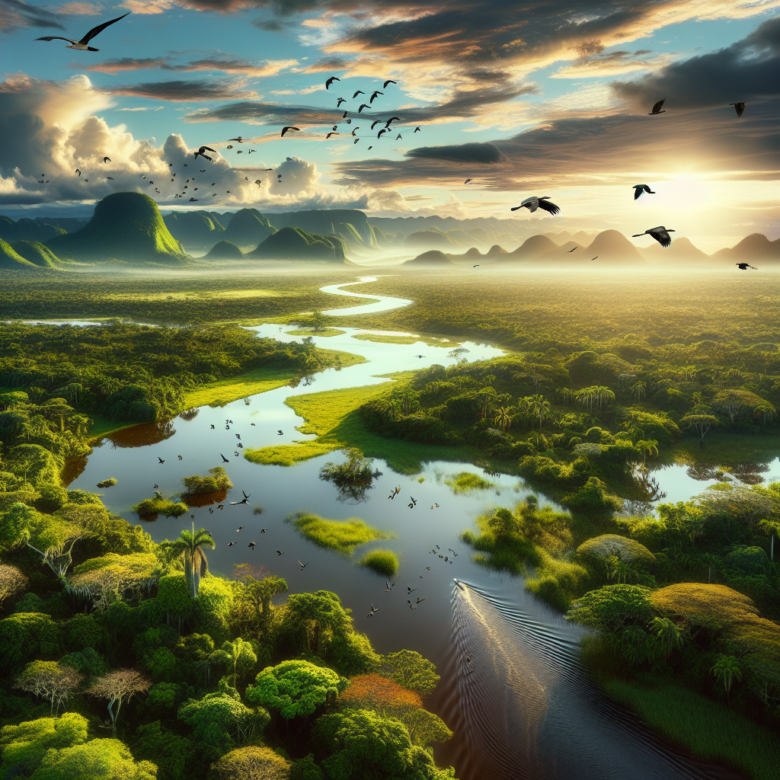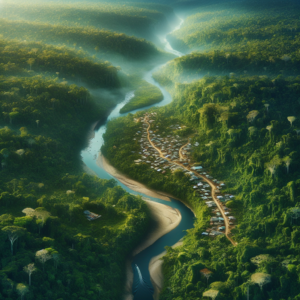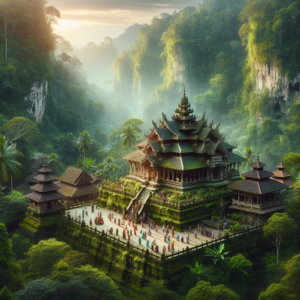The Pantanal, a remarkable biodiverse region, offers a unique blend of stunning landscapes and vibrant ecosystems. This article delves into its rich geography, wildlife, and the intricate environmental dynamics that define this extraordinary area. Join us as we embark on a journey through the wild paths of the Pantanal, uncovering its beauty and significance.
The Geography of the Pantanal
The Pantanal, a marvel of natural geography, is renowned as the world’s largest tropical wetland, sprawling across approximately 140,000 to 195,000 square kilometers (54,000 to 75,000 square miles). This magnificent ecosystem primarily exists within the Brazilian state of Mato Grosso do Sul, though it reaches into neighboring Mato Grosso, Bolivia, and Paraguay. The uniqueness of the Pantanal is attributed to its vast basin, which collects runoff from surrounding highlands, particularly the Planalto formations.
Geologically, the Pantanal is shaped by a concave depression in the Earth’s crust, created during the Tertiary period due to the Andean orogeny. This basin acts as an internal river delta, where several rivers from the surrounding plateaus converge, depositing an array of sediments and nutrients that nourish the region’s rich biodiversity. About 80% of this area experiences seasonal flooding, transforming much of the landscape into a vibrant aquatic environment that supports a myriad of plant and animal species.
The Pantanal’s geographic features include a gently sloping terrain with elevations ranging from 80 to 150 meters (260 to 490 feet) above sea level. This low-lying region is bordered by various ecosystems, including the Chiquitano dry forests to the northwest and the Cerrado savannas to the north and east. The distinct hydrological dynamics are marked by the fluctuating water levels of the Paraguay River and its tributaries, which rise and fall dramatically between the wet and dry seasons.
The intertwining rivers and floodplain habitats foster a highly productive ecosystem, making the Pantanal not only a critical area for biodiversity but also an essential part of the broader Parana-Paraguay Plain. As such, the Pantanal exemplifies a complex interplay of geological formations and hydrological processes that capture the essence of tropical wetland ecosystems.
The Climate and Seasons
The Pantanal operates under a tropical wet and dry climate, presenting dramatic seasonal variations that shape its unique ecosystem. Average temperatures hover around 24 °C (75 °F) annually, but can surge to highs of 41 °C (106 °F) during the peak of the dry season in October. Conversely, the coldest months, particularly June, witness temperatures plummeting to as low as −1 °C (30 °F). The variability ensures that life within the Pantanal is well adapted to the fluctuations, cycling through periods of both drought and inundation.
Rainfall is another critical climatic factor, averaging between 1,000 and 1,250 millimeters (39 to 49 inches) annually, with precipitation primarily occurring from November to March. January frequently marks the wettest month, receiving approximately 340 mm (13 inches) of rain, while June remains starkly dry, averaging just 3 mm (0.12 inches). This rainfall pattern not only influences water levels but also sets the rhythm for the entire biosphere.
As the rainy season unfolds, about 80% of the Pantanal’s floodplains become submerged, transforming the landscape into a thriving aquatic paradise. This flooding plays a crucial role in nurturing the biodiversity of the region, fostering a vast array of species that rely on the seasonal water availability for breeding and feeding. The transition from flooded to dry soils allows for the emergence of various plant species, each adapted to specific inundation durations and soil types.
The ecological implications of such a climate cannot be overstated. The seasonal changes lead to the flourishing of distinct habitats and enrich the Pantanal’s complex food web. As water recedes, it exposes fertile soil, stimulating plant growth and providing sustenance for herbivores, which in turn attract a multitude of predators, further highlighting the intricate dependencies woven into this remarkable wetland ecosystem.
Flora of the Pantanal
The Pantanal is a vibrant tapestry of plant life that flourishes in a unique environment shaped by extreme seasonal variation. During the rainy season, approximately 80% of the floodplains are submerged, creating diverse aquatic ecosystems. **Aquatic plants** such as *Eichhornia crassipes* (water hyacinth) and *Nymphaea* species (water lilies) thrive in these flooded conditions, absorbing nutrients from the nutrient-rich waters and providing vital habitats for many animal species. Their adaptations, such as buoyant leaves and submerged roots, enable them to navigate the changing water levels seamlessly.
In contrast, as the dry season approaches, the landscape transforms dramatically. **Terrestrial vegetation** emerges from the receding waters, including vast stretches of wetland grasses, known as graminoids, and species such as *Typha* (cattails) and *Phragmites* (reeds). These plants possess specialized root structures that allow them to anchor into the varying soil types, which predominantly consist of clayey and sandy soils. Thick, fibrous roots help them withstand prolonged dry periods, while their flexible stems allow them to sway gently in the wind, minimizing damage during harsh conditions.
The **forested regions** of the Pantanal, which include *Vochysia* and *Copaifera*, provide additional diversity. These trees play a critical role in maintaining the ecosystem’s health by stabilizing the soil, preventing erosion, and offering shade and habitat for various wildlife. Such trees have also developed adaptations to periodic flooding; their roots can grow above the waterline during high water events.
Additionally, the **ecotones** between aquatic and terrestrial environments are rich in biodiversity, hosting herbaceous species that can thrive in both conditions, such as *Sphenocleus* and various sedges. This intricate interplay between different vegetation types ensures the resilience of the Pantanal ecosystem, allowing it to endure the dramatic changes wrought by seasonal flooding and drying.
Fauna of the Pantanal
The Pantanal is not only a haven for flourishing vegetation but also a sanctuary for a rich tapestry of fauna that illustrates the intricate dynamics of life in this vast ecosystem. The region boasts an impressive diversity of animal species, with over 1,000 varieties recorded, showcasing a stunning array from majestic mammals to vibrant birds and unique aquatic life.
Among the striking mammals, the jaguar reigns supreme, serving as a top predator who maintains the balance of the food web. The Pantanal cat, a diminutive wild cat, scours the grasslands and forests alike, preying on small mammals and reptiles. Capybaras, the world’s largest rodents, thrive in the wetlands, forming a significant prey base for the region’s numerous predators. Other notable inhabitants include the giant anteater, tapirs, and various species of monkeys, each playing crucial roles within their ecological niches.
Birdlife in the Pantanal is spectacular, with around 650 species gracing the skies. The hyacinth macaw dazzles with its vibrant blue feathers, while the jabiru stork, with its imposing stature, is a symbol of the region’s avian diversity. These birds are not merely residents; they engage in intricate relationships with the vegetation and aquatic ecosystems, aiding in seed dispersal and contributing to the health of the wetlands.
Aquatic life flourishes as well, with countless fish species, reptiles like caimans, and various amphibians that thrive in the seasonal floods. This biodiversity is vital; it not only sustains individual species but also stabilizes the ecosystem. The interdependence observed among species—such as predator and prey relationships—fosters resilience, enabling the Pantanal to withstand environmental changes.
The intricate connections among these species highlight the Pantanal’s delicate balance. The loss of even a single species could lead to cascading effects, underscoring the importance of biodiversity in maintaining the region’s ecological health. As the story of life in the Pantanal unfolds, every animal, from the smallest fish to the largest mammal, plays an essential role in this vibrant and complex ecosystem.
Conservation and Challenges
The Pantanal faces a multitude of environmental challenges that threaten its rich biodiversity and ecological stability. Some of the most pressing issues include **deforestation**, **climate change**, and inadequate **water management**. Deforestation, primarily driven by agricultural expansion, particularly for cattle ranching and soy production, leads to habitat loss for countless species, including the iconic jaguar. It is estimated that significant portions of the Pantanal have been altered or degraded, impacting not only the flora and fauna but also the communities relying on these ecosystems for their livelihoods.
**Climate change** exacerbates these conditions by altering rainfall patterns and increasing the severity of droughts and floods. Higher temperatures can disrupt the delicate balance of the ecosystem, putting immense stress on both aquatic and terrestrial species. For instance, the jaguar, as a keystone predator, relies on a stable environment to hunt and reproduce. Changes in climate can lead to shifts in prey availability and habitat degradation, potentially resulting in population declines.
Water management is another critical issue, as the Pantanal’s health is intrinsically linked to the quality and quantity of its water resources. Poor agricultural practices and industrial pollution often lead to water contamination, affecting not only the wildlife but also local human populations. Over-extraction of water for agriculture and urban development further threatens the region’s hydrological balance.
To combat these challenges, concerted **conservation efforts** are underway. Organizations and government initiatives focus on establishing sustainable practices, such as agroforestry and wetland restoration, promoting awareness, and involving local communities in preservation efforts. The importance of preserving the Pantanal cannot be overstated, as it serves not just as a biodiversity hotspot but also as a crucial component of the global climate system. The future of this unique ecosystem rests on our collective efforts to tackle these environmental challenges head-on.
Conclusão
In conclusion, the Pantanal is not just a vast wetland; it is a dynamic ecosystem that plays a critical role in the ecological balance of the region. Its unique landscapes and diverse flora and fauna highlight the importance of conservation efforts. As we explore these wild paths, may we be inspired to protect this incredible natural treasure for future generations.



